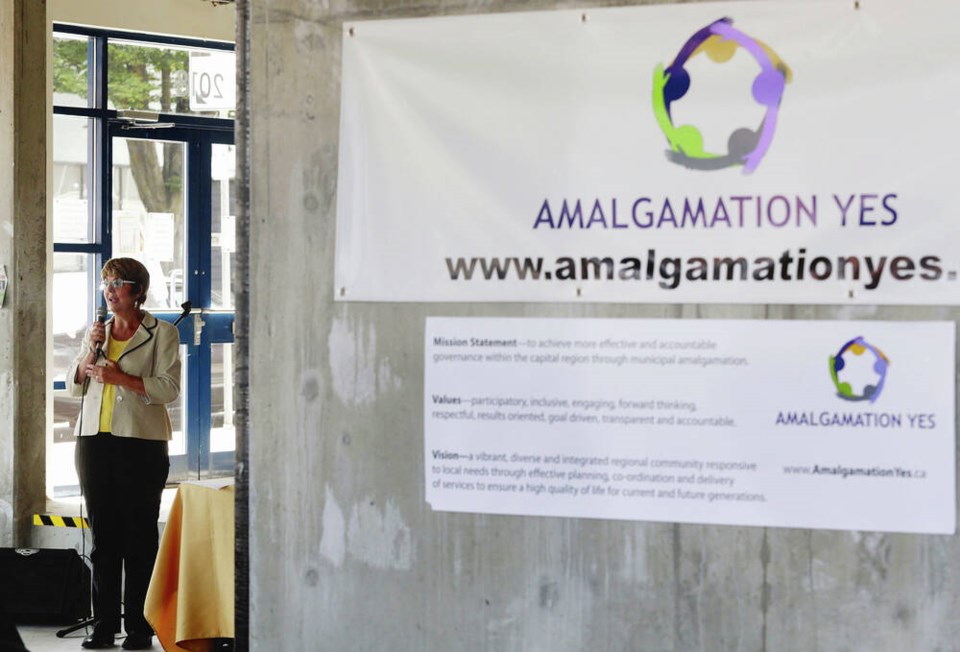It is not surprising that the recent municipal elections in Victoria and the provincial leadership campaign were devoid of any serious discussion on urban governance. The low turnout of voters and the high turnover of mayors and councillors suggest both a lack of interest in municipal issues and a dissatisfaction with how councils are governed.
The silence of provincial politicians suggests there is little desire for amalgamation or for taking responsibility for the disjointed services, diverse planning and the transportation shortcomings in the capital region.
The provincial legislation is designed to make amalgamation next to impossible. Municipalities wishing to join together must hold a vote and all be in favour. Anyone who has followed Victoria politics knows how unlikely that is.
To complicate matters, there is not a ward system for the election of councillors. With a reduced number of councillors in a consolidated Victoria, a ward system is necessary. It gives constituents a representative on council who can advocate on their behalf and respond to local issues. B.C. is the outlier when it comes to wards.
Residents and organizations pushing for amalgamation have focused their attention on building support from residents and municipalities. While this is helpful, the power for change is with the province. The focus of lobbying should be directed at persuading provincial politicians to act.
Incoming premier David Eby, a former housing minister, knows that “municipalities are the creatures of the province.” His proposals for dealing with the affordable housing crisis show he understands.
He is prepared, in spite of opposition, to put in place zoning conditions that will permit multi-unit housing in the residential areas of B.C. urban regions.
For an example of what a province can do, one need look no further than Ontario’s municipal elections in 2018. Without consultation during the Toronto election campaign, the province unilaterally decreased the number of wards from 47 to 25. City council took the reduction of wards to court and lost.
The rest of Canada has recognized that metropolitan regions need integrated services, an equalized tax base, and better planning, transportation and governance.
The Prairies have a tradition of single regional municipalities. And in the 1990s Ontario, Quebec and Nova Scotia undertook the reorganization and the amalgamation of their metropolitan regions.
While not all were perfect, and initially there were some problems, there has been overwhelming acceptance of the results. Again B.C. is the outlier when it comes to the consolidation of its urban regions.
Often arguments in favour of consolidation of the Victoria region are about the potential savings, the exorbitant number of councillors, and the duplication of senior management and staff.
While, with improved governance, there can be savings in the medium and long term, savings is only one of the reasons.
When one municipality pays the total municipal portion of the cost of a bridge that is frequently used by everyone, the tax base in the region is unfair.
When there are five policing systems and 13 fire departments, when local planning and transportation rest with the individual municipalities, and when there are mixed responsibilities for portions of the water, sewer and stormwater services, one wonders why the province has failed to deal with the governance of the region.
While opposition to amalgamation may appear strong, it usually is led by local politicians. Yet after an amalgamation there are few noticeable changes in the delivery of basis services, and there are few examples of long-term opposition.
Local politicians who get elected soon are immersed in both the day-to-day governing of the city and in representing their wards.
Provincial politicians have the false impression that amalgamation will have consequences for them in the next election. There is little in the amalgamations of the 1990s to support this fear. The province, with consultation and an understanding of the complications, can complete an amalgamation in two to three years.
Over the past number of years there has been increased growth in Saanich, View Royal and the West Shore communities, and actually decreases in the populations of Esquimalt and Oak Bay.
While the exact boundaries, the municipalities to be included, and the complications of integrating services, budgets, and staffing are complex problems, they are manageable.
It is time for the province to have the vision and take leadership in the consolidation of the metropolitan area of the capital region.



